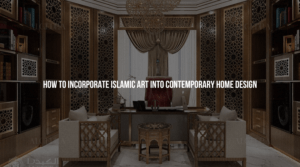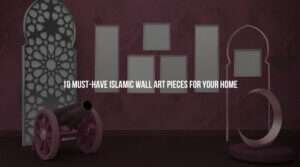When it comes to home decor, blending tradition with modernity is an art form that creates a uniquely personal space. For Muslims, traditional Islamic decor is more than just aesthetics; it reflects cultural heritage, spiritual grounding, and reverence for beauty as encouraged in Islamic teachings. By mixing traditional Muslim home decor with modern furnishings, homeowners can design a space that is both contemporary and deeply rooted in Islamic values. Whether it’s Islamic wall art, intricate Arabic calligraphy, or beautifully designed prayer mats, incorporating these elements can add elegance and character to any space. Here’s how you can blend traditional Islamic decor with modern furnishings to create a balanced, harmonious home.
1. The Foundations of Islamic Decor
Islamic decor has a rich history rooted in patterns, colors, and symbolism that convey cultural and spiritual significance. Unlike conventional art, Islamic art is non-figurative, focusing instead on intricate geometric patterns, calligraphy, and arabesques that reflect the divine. Islamic wall art often incorporates Quranic verses, supplications, and meaningful words in Arabic, crafted with intricate patterns that evoke a sense of peace and contemplation.
When integrating Islamic decor into modern spaces, it’s essential to remember that each piece serves as both a decorative element and a reminder of faith. Items like Muslim home decor pieces from Kiswah Islamic Store, including lanterns, framed calligraphy, and Islamic wall art, bring in the traditional while blending effortlessly with a contemporary aesthetic.
2. Balancing Tradition with Modernity
Blending traditional Islamic decor with modern furnishings is all about balance. The clean lines and neutral tones of modern design provide a simple, uncluttered backdrop for the vivid patterns and intricate details typical of Islamic decor. For example, placing a large Arabic calligraphy piece on a simple, light-colored wall or adding a patterned rug to a sleek, minimalistic room can bring a beautiful contrast.
Start by choosing one or two Islamic art pieces to be the focal points in each room. This could be a hand-carved wooden Quran stand in the living room or a bold, large Islamic wall art piece in the dining area. Let these traditional elements stand out against modern furniture to create a cohesive look that respects both aesthetics.
3. Using Color to Enhance Harmony
Color plays a crucial role in both traditional and modern decor. While traditional Islamic decor often features rich hues like emerald green, deep blue, gold, and terracotta, modern spaces favor neutral tones such as white, beige, or gray. By combining these color palettes, you can create a balanced environment that feels timeless and vibrant.
Consider adding a traditional Islamic rug with deep, bold colors to a modern living room with neutral furniture. Alternatively, a minimalistic setting can benefit from accents like colorful Islamic calligraphy or an intricately designed prayer mat. Kiswah Islamic Store offers a wide range of colors and patterns, so you can find pieces that complement both traditional and modern aesthetics.
4. Incorporating Islamic Calligraphy as Art
Islamic calligraphy is one of the most popular forms of Islamic decor and an excellent choice for adding a touch of tradition to modern spaces. The elegance of the Arabic script conveys a sense of fluidity and grace, making it a beautiful focal point in any room. A large canvas featuring Quranic verses or an intricately framed calligraphic piece can instantly bring spirituality and a sense of identity into a space.
When displaying Islamic wall art, placement is key. A striking piece above a sofa in the living room or over a bed in the master suite creates a balanced, harmonious look. For a bolder approach, consider mixing different calligraphy pieces in various styles to create a gallery wall. This approach not only celebrates the beauty of Islamic art but also adds depth and sophistication to the room.
5. Mixing Materials and Textures
One of the best ways to merge traditional and modern styles is through textures and materials. Traditional Muslim home decor often incorporates materials like wood, brass, and textiles with intricate detailing. Modern furnishings, on the other hand, tend to favor clean, sleek surfaces such as glass, chrome, and polished metals.
Mixing these materials adds texture and depth to your Muslim home decor. For example, a brass lantern with an intricate pattern from Kiswah Islamic Store can complement a modern coffee table made of glass. Consider adding a traditional woven rug or a wooden prayer stand to a room with contemporary furniture, creating a perfect fusion of old and new.
6. Incorporating Traditional Lighting
Lighting is an essential part of both traditional and modern decor. Traditional Islamic decor often includes ornate lanterns, which cast beautiful patterns and create a warm, inviting ambiance. Incorporating these lights in a modern setting can enhance the space and give it a serene, welcoming feel.
Choose Moroccan or Turkish-inspired lanterns that feature traditional designs and place them in areas where they can stand out. Hanging a brass lantern in a minimalist living room or placing small lamps with Islamic motifs on bedside tables can add charm while keeping the decor cohesive.
7. Creating a Tranquil Prayer Space
For many Muslim homes, a dedicated prayer space is an essential part of the decor. This can be a small area in a bedroom, living room, or even a balcony. Designing a prayer space with traditional Islamic decor adds a sense of tranquility and spirituality to the home. Consider using a beautifully designed prayer rug, adding a Quran stand, and incorporating small calligraphy pieces to create an inviting area for worship.
Even in a modern home, this prayer space can be enhanced with subtle touches of traditional Islamic decor, creating a spiritual corner that reflects one’s beliefs while blending with the overall design.
8. Adding Greenery
Plants bring life and vitality to any space, making them a perfect addition to both traditional and modern interiors. Indoor plants are a popular choice for adding freshness to Islamic-inspired decor as well, symbolizing growth and creation. Pairing greenery with Islamic art or calligraphy can soften a room and add an element of natural beauty.
Place potted plants near Islamic wall art or create a small garden-inspired corner with hanging calligraphy, lanterns, and greenery. This brings harmony and a touch of nature to your modern yet traditionally inspired home.
Conclusion
Mixing traditional Muslim home decor with modern furnishings is a beautiful way to pay homage to one’s heritage while embracing a contemporary lifestyle. Whether through Islamic wall art, calligraphy, or prayer spaces, traditional elements can coexist with sleek, modern furniture to create a balanced, harmonious living space. By carefully choosing decor from trusted sources like Kiswah Islamic Store, you can achieve a timeless aesthetic that respects both past and present, tradition, and innovation.




